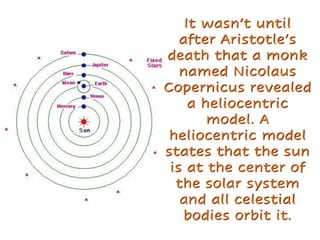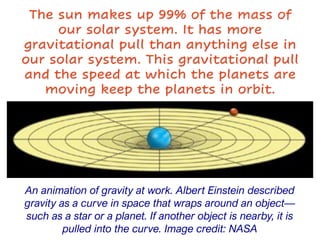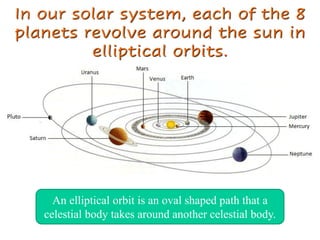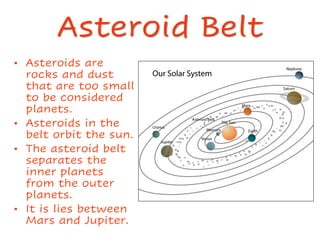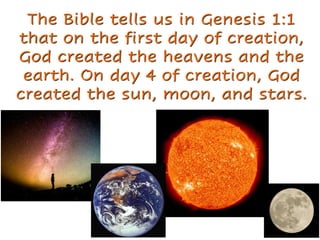Our Solar System
- 1. Our Solar System Created by Marie @ thehomeschooldaily.com
- 2. The Solar System is made up of the sun and other celestial bodies that orbit the sun. These bodies include 8 planets, dwarf planets, over 100 moons, and countless asteroids, comets, and meteoroids.
- 3. Our solar system is found in the Milky Way Galaxy. The sun is one of billions of stars in this spiral galaxy. The sun is a medium sized star. It is our source of energy, light, and heat.
- 4. There have been two ways of thinking about how the Earth and other planets move in space. One is called a geocentric model and the other is called a heliocentric model.
- 5. At one time, a scientist named Aristotle made claims to a geocentric model. A geocentric model states that the Earth is the center of the universe and that all celestial bodies orbit the Earth.
- 6. It wasnât until after Aristotleâs death that a monk named Nicolaus Copernicus revealed a heliocentric model. A heliocentric model states that the sun is at the center of the solar system and all celestial bodies orbit it.
- 7. Planets orbit the sun because of gravity. Objects that have more mass have more gravity. Gravity also gets weaker with distance. The Sun and planets to scale. Credit: Illustration by Judy Schmidt, texture maps by BjÃķrn JÃģnsson Gravity is the force of attraction that all objects with mass have between each other.
- 8. An animation of gravity at work. Albert Einstein described gravity as a curve in space that wraps around an objectâ such as a star or a planet. If another object is nearby, it is pulled into the curve. Image credit: NASA The sun makes up 99% of the mass of our solar system. It has more gravitational pull than anything else in our solar system. This gravitational pull and the speed at which the planets are moving keep the planets in orbit.
- 9. In our solar system, each of the 8 planets revolve around the sun in elliptical orbits. An elliptical orbit is an oval shaped path that a celestial body takes around another celestial body.
- 10. MY VERY EXCITED MOTHER JUST SERVED US NACHOS! Mercury Venus Earth Mars Jupiter Saturn Uranus Neptune
- 11. The 8 planets can be divided evenly into 2 groups, the inner planets and the outer planets. Jupiter Saturn Uranus Neptune Mercury Venus Earth Mars INNER PLANETS OUTER PLANETS
- 12. Mercury, Venus, Earth, and Mars make up the inner planets. They are also called terrestrial planets. Terrestrial planets have solid surfaces that are comprised mainly of rocks and metals. MERCURY VENUS EARTH MARS
- 13. Mercury âĒ Closest planet to the Sun âĒ Speediest Planet- moves 30 miles a second! âĒ Thinnest Atmosphere âĒ Planet of extreme hot and cold temperatures âĒ Smallest planet âĒ 2nd most dense âĒ No satellites A satellite is an object that orbits a larger object. Example: Moon
- 14. Venus âĒ Nicknamed âMorning Starâ and âEarthâs Twinâ âĒ One of the brightest objects in the sky due to its reflective clouds âĒ Thickest atmosphere causes the Greenhouse Effect âĒ Hottest planet âĒ Retrograde Rotation- rotates backwards âĒ No satellites It is called Earthâs twin because they are relatively the same size.
- 15. Venus' hot temperature is due to what we call "the Greenhouse Effect." The large amount of carbon dioxide in Venus' atmosphere acts like a blanket. The heat gets trapped underneath the thick layer of clouds. Because the heat has nowhere to go, Venus gets hotter and stays hot.
- 16. Earth âĒ Most dense planet âĒ Has seasons âĒ Atmosphere with water and air âĒ Has life including humans, plants, and animals âĒ 1 Revolution= 1 year âĒ 1 Rotation= 1 day âĒ 1 satellite A revolution is one trip around the sun. A rotation is one complete turn on a planetâs axis.
- 17. Mars âĒ Nicknamed Red Planet due to the iron oxide (rust) on its surface âĒ Polar caps at the poles âĒ Seasons just like Earth âĒ Largest known volcano called Olympus Mons âĒ Huge canyon known as Valles Marineris âĒ 2 satellites The icecaps are made of dry ice (frozen carbon dioxide) and small amounts of water.
- 18. Asteroid Belt âĒ Asteroids are rocks and dust that are too small to be considered planets. âĒ Asteroids in the belt orbit the sun. âĒ The asteroid belt separates the inner planets from the outer planets. âĒ It is lies between Mars and Jupiter.
- 19. The outer planets are also called gas giants. Gas giants are much larger than terrestrial planets. They are comprised primarily of gases, liquids, and ice. JUPITER SATURN URANUS NEPTUNE
- 20. Jupiter âĒ Largest Planet âĒ Made up mostly of hydrogen and helium âĒ Faint ring system âĒ Has more than 75 satellites âĒ Has a Great Red Spot that is an ongoing storm Jupiter is so BIG that all the other planets could fit inside it!
- 21. Saturn âĒ Least Dense Planet âĒ Spectacular rings made of ice and dust âĒ Second largest planet âĒ Has more than 80 satellites Despite Saturnâs size, it could float in a bathtub of water!
- 22. Uranus âĒ Rotates on its side and east to west âĒ Blue color from methane in atmosphere âĒ 13 dark rings âĒ Thought to have oceans of water, ammonia, and methane above a solid core âĒ Has more than 27 satellites
- 23. Neptune âĒ Most distant planet from the sun âĒ Dark, cold, and windy âĒ 6 Faint Rings âĒ 13 known satellites âĒ Visible Clouds âĒ Blue color is from methane in the atmosphere
- 24. The Bible tells us in Genesis 1:1 that on the first day of creation, God created the heavens and the earth. On day 4 of creation, God created the sun, moon, and stars.
- 25. Check out our other homeschool resources at The Homeschool Daily! The heavens declare the glory of God; and the firmament sheweth his handywork. Psalm 19:1






